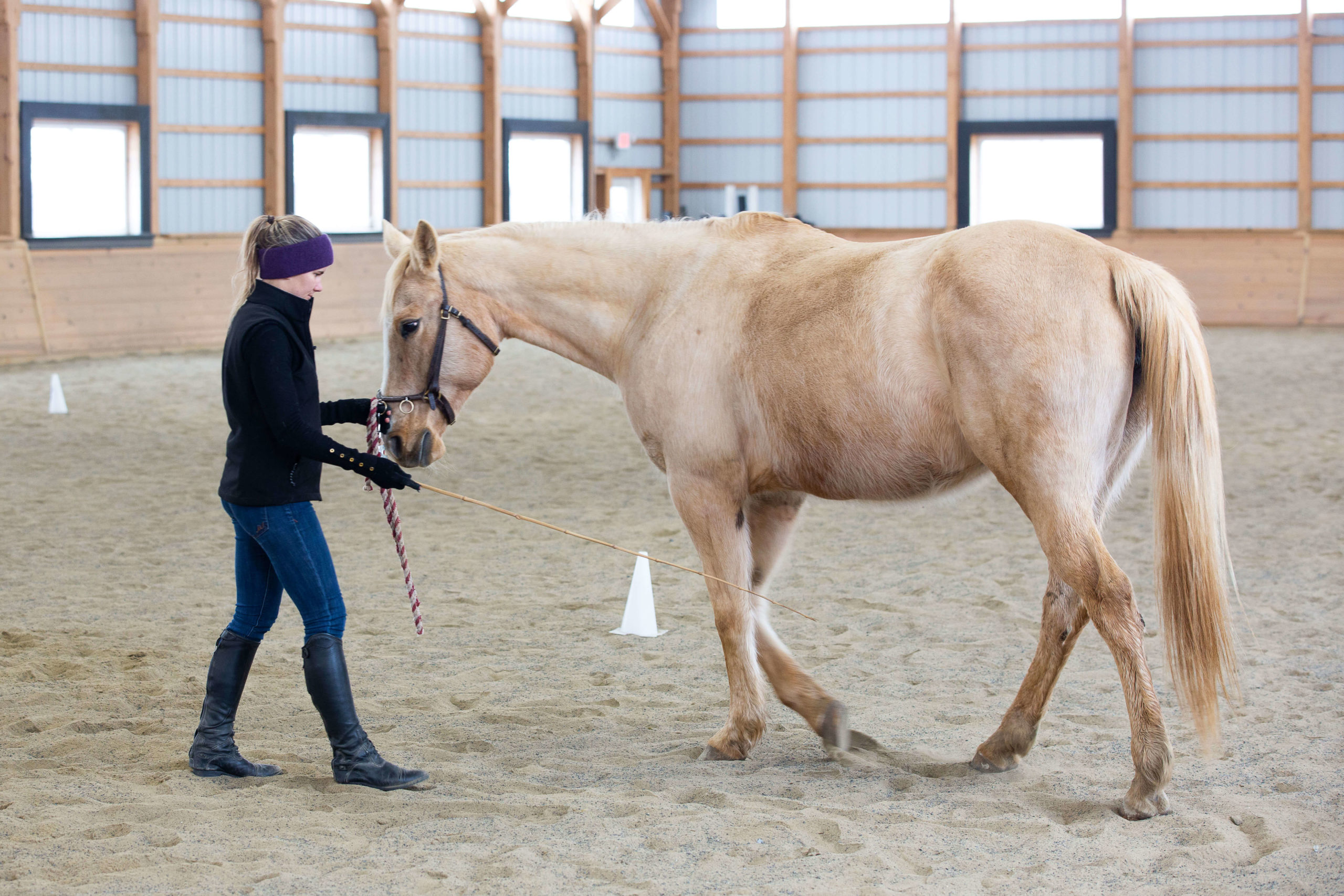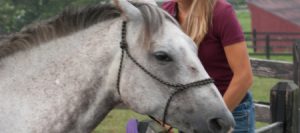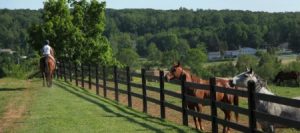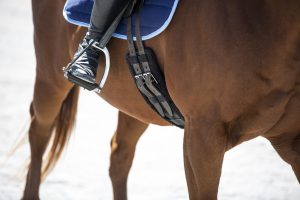Feel.
A term commonly used by horsemen, you may have an intuitive understanding of the word, but it is difficult to define. What does it really mean to have feel? Can it be taught?
In the following paragraphs, I’m going to attempt to define feel and share a few simple exercises you can use to improve your own feel.
I would describe feel as an awareness of your horse and of yourself. It is making observations and reading the horse, but at a glance. Going further than reading the horse, feel is awareness of emotion, of tension, pressure, movement and what might be coming next.
When we experience true feel, it’s not a cognitive process, it is a sense, a knowing. Feel is the unconscious mind at work, using prior learning to process information and make assumptions quickly.
It is the mind and sense of the expert. Everyone experiences feel in different contexts, for example driving a car and judging the speed and distance of other traffic to smoothly and safely merge across lanes, or in seeing the face of a child or spouse and instantly knowing their emotional state.
In a professional setting, feel could be an experienced doctor knowing the diagnosis of a patient even before a complete exam, or a seasoned golf player lining up and using just the right amount of swing for a perfect shot.
In these examples, feel does not happen through any kind of magic or even unexplainable knowing. Rather, it happens out of the process of observing and learning over time, until our brains can process the information from our senses so quickly we no longer consciously think through all of the information, but instead we just get a sense of the situation.
If you’ve been driving for years, you no longer have to think about how to merge, and all the pieces of information and action required to get it right – the speed of the car coming up behind, the right amount of acceleration, turning the wheel, hitting your blinker, straightening back out to stay in the lane… you just look in the mirror and go.
The same process happens with our horsemanship and riding.
An experienced rider sits on a horse and can feel where that horse puts his weight and how much pressure to use from a leg aid to bring him into better balance. Or the experienced rider is able to pick up on the tension the horse carries through his neck and use the rein in just the right way to encourage the horse to soften and move more freely.
While I just described feel as the sense of the expert, you will experience many moments of feel long before becoming an expert. You will find feel at different stages as you build up enough experience in that skill and situation for your unconscious mind to do its work.
You may start to feel your horse at the walk, and handle the reins softly, knowing just the right amount of pressure to use when going slow. When the pace picks up, that feeling may disappear, and you may find you are right back to thinking through each step of the process vs. feeling your way through it. But as you continue to learn and build your skills, the experience of feel will come more often.
We tend to experience feel when we are in a state of flow. Flow is experienced when both your ability level and the level of challenge, for any given task, are both high.
We can find flow in even simple tasks, but the key is this sweet spot between ability and challenge. If the task is too hard and our ability too low, we become anxious, if too easy, we become bored. The experience of feel will come when we are challenged, but have the skill set to meet that challenge – whether the challenge is cantering a jump course or walking an even circle.
I’m working on an article to go into detail on the science of flow and how we can achieve it as riders, so look for that next week.
While feel exists when we are in a state of flow, we don’t always need to be in this state to experience the horseman’s definition of feel.
However, to find feel we do need to be present, attentive, and attuned to our senses.
Next, I’m going to describe several simple exercises to improve your feel.
#1 Breathe
Pay attention to your breathing to connect to yourself and become more aware of your senses. This may seem over-simplified, but focusing on your breath brings you into the present and is the easiest awareness exercise one can do.
#2 Practice Handling the Reins with Greater Awareness
While in the saddle, you can also do an easy exercise with your reins. Take one rein at a time and slide your hand down the rein and then back up. Practice both keeping a soft contact as you slide your hand as well as beginning with a loose rein and sliding your hand until you just pick up a bit of contact and then letting the rein go loose again.
The video below will show more clearly how to do this.
This can improve your feel of the rein, give you a sensation to focus on, and create slow calming movement.
#3 Develop Your Sense of Touch
Touch is very powerful. For social animals, such as humans and horses, touch is a powerful tool for bonding. Different types of touch however, can trigger very different responses.
The next exercise is out of a book I reference often, Linda Tellington Jones’ book, Improve Your Horse’s Well-Being.
This exercise will help you practice feel in noticing different amounts of pressure and being able to adjust the pressure that you use.
In the book, Linda describes a scale of pressure, and recommends practicing these different levels of pressure first on yourself, and then through a series of touches with your horse.
I will also describe these different levels of pressure in the video below and you can purchase Linda’s book here.
After watching the video, leave a comment – when have you experienced feel? How would you describe it?
See you in the comments,
Callie














41 Responses
I’ve been working with increasing contact with my quarterhorse, Cool and it has made a huge difference. By placing a little more tension on the reins we seem to be establishing more of a partnership as we ride and I feel Cool coming up underneath me and dropping his head. I did this AFTER messaging the reins as we rode for a few weeks so we could get a feel for each other before applying a little more contact on the reins. I also give the reins as he lowers his head. Feels lovely!
Awesome Michele! Experimenting with feel is a great way to get more practice
-Julia Burdy, CRK Training Community Manager
When trotting and he gave, feels weightless..this info is good because to fast I loose it or to anxious I loose and go too fast too much…would love to see more rein exercise. I have been told not To throw reins away even on TRAIL ride and that is where it goes to hell…I either have too much or not enough contract…thax. T
Tracey, the rein exercise in this video should be helpful for you to practice out on the trail (if you feel comfortable doing so!).
-Julia Burdy, CRK Training Community Manager
On the last few times I have been out on my trail rides when we are simply walking through the wood I have really been paying attention to the feel of his muscles as we move.
Elizabeth, on the trail is a great time to practice and focus on feeling the horse!
-Julia Burdy, CRK Training Community Manager
I wish you were in Australia so I could do your clinics. You make so much sense.
Liz, that is why we love sharing our online courses – so we can help riders from all over the world
-Julia Burdy, CRK Training Community Manager
I can now feel when each hind leg is coming off the ground.
Awesome Gretchen!
– Julia Burdy, CRK Training Community Manager
I am working with my mare to stretch over her topline and step under behind. Thurs. I some trot work that felt like she was pushing from behind, stretching, and not on her forehand. What a great feel! I am going to ty the exercises tomorrow. I also look forward to the next article about “flow”.
Thanks Callie for always giving me more to think about.
Dani, that is awesome! I’m so glad to hear you had that great feel from your mare – there is nothing better
-Julia Burdy, CRK Training Community Manager
I love that you are integrating the TTeam and Feldenkrais work in your teaching!
What I feel most are the changes in his mood. Sometimes he feels so relaxed and happy, other times he feels nervous and jumpy or crabby and uncooperative.
Being in touch with your horses mental state is a key part of keeping you safer when working around him or riding! I find myself deciding not to ride on certain days if I can feel that my horse is in a heightened state of emotion and instead on those days we groom or do something that requires a little less from him.
-Julia Burdy, CRK Training Community Manager
On our trail ride today, I had a nice sense of “feel” when I asked for a lateral step and she felt balanced and even going sideways. Very pleasant for both of us!
Fantastic, that is awesome Beverly!
-Julia Burdy, CRK Training Community Manager
I’ve been working really hard to improve my feel with my horse. I’m discovering that I have a long ways to go. I’m glad that I have a patient horse and he appears to like me. I’ve tried some t-touches with him and I’ve discovered that he prefers a very light pressure, like a level 1 or 3. This is difficult for me to do because I’m an exuberant person and I sometimes have a tendency to go overboard with my touch. I experienced feel today riding in the arena. I was riding with my bareback pad and a new Myler snaffle bit. This bit is ALOT more gentle than his old Tom Thumb bit. My horse positively moved out! I almost fell off a couple times. He was a happy horse. Even playful. It dawned on me that that I need to really work on my hands. I’ve been using too much pressure. Will try your exercise. Less really is better.
Kathleen, the reins exercise that Callie demonstrates in the video would be a great exercise for you to practice for your hands!
– Julia Burdy, CRK Training Community Manager
Hi Callie
A great video on a concept that is most definitely hard to describe in words. I find that I have “moments” of feel when at the trot I can feel the consistent, relaxed gait of my horse; everything is in sweet harmony. As a former tennis player, I think of feel as that “sweet spot” when you hit the ball in the center of the racquet and you just know that you hit that ground stroke winner. It just “feels” great! I think we are looking for the same thing in our riding.
Nancy
Great analogy, couldn’t agree more! Thanks for sharing Nancy
-Julia Burdy, CRK Training Community Manager
Being new to riding, I use breathing constantly to keep myself calm. I’ve experienced feel a few times when using my calves/legs correctly to have my horse turn or go faster. I struggle with increasing to the right amount of pressure to get a response.
Hi Vena! If you are able to, try experimenting with how little pressure you have to use to get the response you are looking for from the horse you are riding. Notice if this changes when you are different horses as well!
-Julia Burdy, CRK Training Community Manager
That is the BEST explanation Any one has ever said I can’t wait to try this
You’re so kind Jean! Please let us know how you make out trying this concept
-Julia Burdy, CRK Training Community Manager
A FANTASTIC explanation of an abstract concept. Well done! I’ll be sharing it for sure!
Thank you! And thank you for sharing
-Julia Burdy, CRK Training Community Manager
Thank you Callie
I have the best feel when i am in a very positive mental state, really enjoying myself and not thinking of much besides how well we’re working together. Not trying, ever thing just flows even if it just occasionally for a short time.
Great insight, it is incredible how much better we can feel when we stop trying so hard
– Julia Burdy, CRK Training Community Manager
Hey Callie,
I went on a beach ride on Saturday. I was a bit nervous as it’s the first time I’ve ridden out in a few years. I really focused on my breathing, tension and horses ears when things were going on in our surroundings, such as; a quad bike pulling a trailer close by and a really high pitched dog barking. We had a great ride. That is my recent experience of feel. Thanks for the video from the Isle of Wight UK.
Julie, that sounds like a fabulous time riding on the beach! Thanks for sharing
-Julia Burdy, CRK Training Community Manager
Thank you for your help on this topic. It couldn’t have come at a better time as I am getting my mare ready for a dressage show and have been putting too much pressure on her. She is normally a very laid back,( almost too laid back) mover, but through too much pressure she and I have become stiff and anxious. I noticed this when practicing stretching in the test, I noticed when I started to relieve pressure and encourage stretching, she actually had a better stride and started to relax a bit. It’s a touchy topic, and will use your advice to hopefully become more aware of how I ask and how much pressure to use.
Lynn, awesome! I think it is definitely easy to become to task driven and that can easily cloud ‘feel’ for what the horse needs from you! Best of luck at your upcoming show
-Julia Burdy, CRK Training Community Manager
Nice video Callie! I loved the “combing the reins” exercise from Linda’s book. For me, feel starts when I first see my horse. I get a sense of where he/she is at, it’s kind of an essence and then I watch as I bring them in from the field, groom them and tack up to see if anything shifts. I’ve had several super sensitive horses who show you exactly how they’re feeling and sometimes I take on that feeling. I can feel their nervousness or whatever and I’ve had to spend a lot of time on myself to be super grounded before working with any horse to avoid taking on their energy and to be able to guide them to an energetically neutral place. Being able to hold my own energy and inspire a safe space for them is an ongoing journey. Some horses are way easier than others. Of course this also translates into riding. As you mention, I find conscious breathing and observation to be great places to start. Thanks for all your great work.
Great video, Callie. I’m TTouch practitioner and enjoyed the way you related Linda’s pressure scale to contact on the reins. A great reminder for riders of all levels!
Hi Julia -& CRK – my issue is related to “feel.” I ride in a jump saddle, and I find it really difficult to maintain the plumb line – I expend too much effort trying to achieve this. I notice that Callie does most of her teaching videos in a jump saddle – can you offer any insight into maintaining leg position in jump saddle? I would love to see a video of riding each gate in a jump saddle. Thank you!
Kate, it may be that the particular jump saddle doesn’t fit you well and that is what is making it so difficult for you to find the correct alignment. Click here to watch a video we did on the blog about Saddle Fit for Riders.
-Julia Burdy, CRK Training Community Manager
Hi Callie and Julia! What a great video! I experienced feel when I was taking an XC jumping lesson last year. I do a lot of yoga and was a little nervous, so I concentrated really hard on taking long yoga breaths in and out. I realized my horse was matching his strides to my breath! I didn’t believe it at first, so I took short, quick breaths one trip around the course and he got really short strided and nervous. I’m a believer in the importance of feel and the power of breathing!! Thanks for all the great info!
What a fantastic little experiment Breath does definitely have a huge impact on our riding!
Breath does definitely have a huge impact on our riding!
-Julia Burdy, CRK Training Community Manager
Loved your description and exercises for feel and a light touch. I’m sure they will be on my mind the next time I ride. I like to think of the lightest pressure as just a thought